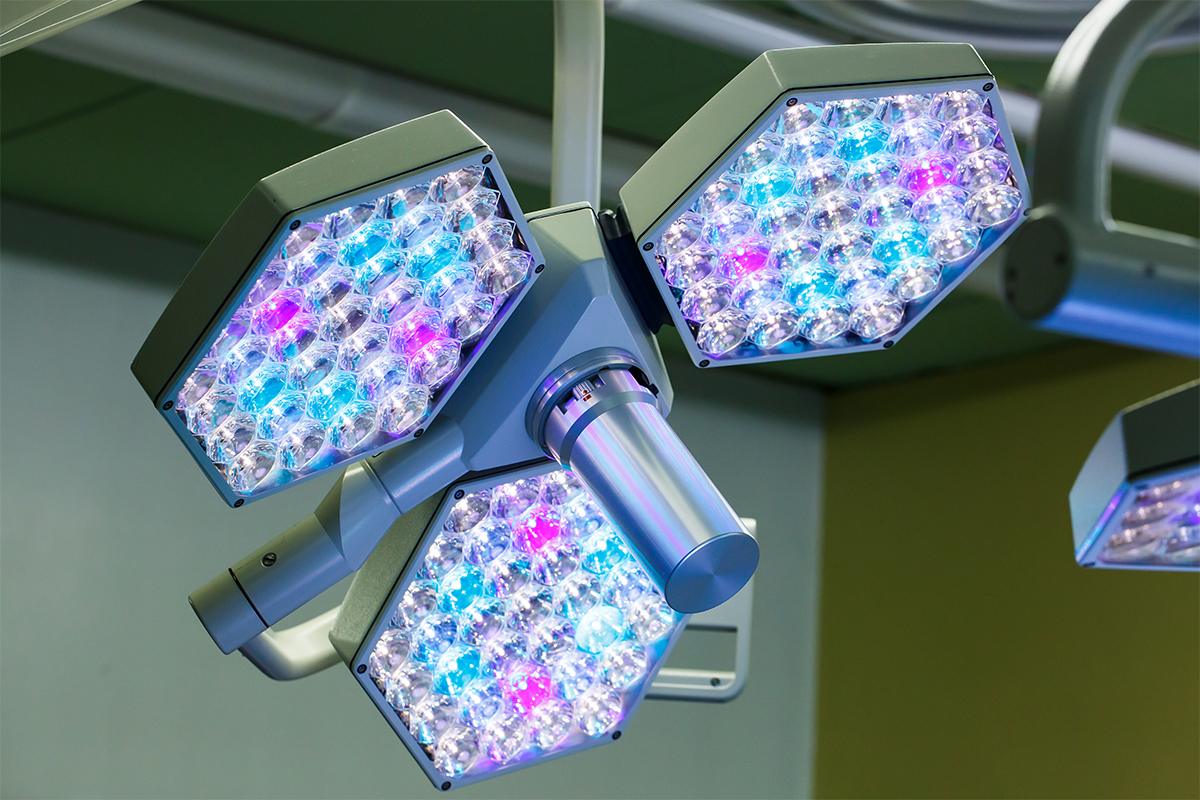Surgical lights
Surgical lights, also known as
operating room lights, are designed to provide optimal illumination that supports surgical precision, enhances visualization, and ensures patient safety and comfort throughout the surgical process. Surgeons need to accurately assess the anatomy of the patient's body and identify specific organs, tissues, blood vessels, and other structures involved in the surgical procedure. Precise visibility allows them to make informed decisions and execute surgical maneuvers effectively. Surgeons must navigate through delicate and intricate anatomical structures without causing damage to surrounding tissues or organs. Clear visibility enables them to navigate with precision and avoid unintended injuries or complications. In some cases, surgeons may need to identify and remove abnormal or diseased tissues, such as tumors or damaged organs. Precise visibility ensures that they can accurately locate and address these pathologies while minimizing the risk of leaving any diseased tissue behind. Throughout the procedure, surgeons need to continuously monitor the surgical field to ensure that everything is progressing as planned. Clear visibility allows them to maintain control over the surgical environment and respond promptly to any unexpected developments or complications. Surgical lights are engineered to minimize shadows, reduce glare, and provide consistent, high-quality lighting to ensure the surgical team can perform procedures accurately and safely. With a clear view of the surgical field, surgeons can perform surgical tasks with confidence and precision. This includes tasks such as incisions, suturing, tissue manipulation, and the removal of diseased or damaged tissues.
Critical illumination
Surgical lights serve essential functions in the operating room by providing bright, shadow-free illumination, enhancing surgical precision, promoting visual comfort, and adapting to the diverse needs of surgical procedures. Their design and functionality are tailored to optimize visibility and support the success of surgical interventions. The primary function of surgical lights is to provide bright and focused illumination of the surgical field. This illumination ensures that surgeons and medical staff have clear visibility of the area where the surgery is taking place, enabling them to perform procedures with precision and accuracy. Surgical lights are designed to minimize shadows and glare, which can obstruct visibility and hinder surgical performance. By providing even and shadow-free illumination, surgical lights help to eliminate visual obstacles and ensure that surgeons can see the surgical site clearly from various angles. Clear and well-directed lighting from surgical lights enhances surgical precision by enabling surgeons to accurately identify anatomical structures, differentiate between tissues, and perform delicate maneuvers with confidence. This precision is crucial for achieving optimal surgical outcomes and minimizing the risk of errors or complications. Surgical lights are also designed to provide visual comfort for surgeons and medical staff during prolonged surgical procedures. By offering adjustable brightness levels and minimizing glare, surgical lights help to reduce eye strain and fatigue, allowing surgical teams to maintain focus and concentration throughout the procedure. Many surgical lights are equipped with adjustable features, such as variable
color temperature, intensity control, and positioning flexibility. These features allow surgical lights to adapt to the specific requirements of different surgical procedures and accommodate the preferences of surgeons and medical staff, ensuring optimal lighting conditions for each case.
The impact of LED technology on surgical lights has been significant, leading to advancements that enhance the effectiveness, efficiency, and safety of surgical procedures. LEDs consume significantly less power while still delivering bright, consistent light output. This energy efficiency not only reduces operating costs but also contributes to sustainability efforts by lowering energy consumption and carbon emissions.
LED lights have a much longer lifespan compared to conventional bulbs. This extended lifespan also minimizes disruptions during surgical procedures, as there is less need for downtime to replace bulbs. LED lights are compact and lightweight compared to traditional lighting fixtures, making them easier to maneuver and position in the operating room. Their smaller size also allows for more versatile mounting options, maximizing the coverage of the surgical field without obstructing the surgical team's line of sight. LED lights provide high-quality illumination with excellent
color rendering properties. This means that the light emitted closely resembles natural sunlight, allowing surgeons to distinguish between tissues more accurately and perform procedures with greater precision. The absence of radiant heat emission from LED surgical lights reduces the risk of tissue damage during surgical procedures. Excessive heat can cause tissue desiccation, coagulation, or thermal injury, particularly in delicate or sensitive tissues. Surgeons, assistants, and other medical staff can work for extended periods without experiencing discomfort or fatigue associated with exposure to excessive heat. This promotes better concentration and performance during surgical procedures. LED surgical lights often feature adjustable parameters such as color temperature and brightness levels. Surgeons can customize these settings to match their preferences and the specific requirements of different procedures. This flexibility allows for optimal lighting conditions tailored to each surgical case, enhancing visibility and surgical precision.
Ceiling-mounted LED surgical lights
Ceiling-mounted LED surgical lights are affixed to the ceiling of the operating room. This positioning ensures that they provide overhead illumination, covering the entire surgical field with bright and focused light. These lights serve the primary purpose of illuminating the surgical area during procedures. Their placement on the ceiling allows for optimal coverage and visibility, enabling surgeons and medical staff to perform surgeries with precision and accuracy. Ceiling-mounted LED surgical lights typically feature adjustable arms and heads. These components allow for flexibility in positioning and focusing the light beam onto the surgical field. Surgeons can adjust the orientation and angle of the lights to direct the illumination precisely where it's needed, ensuring optimal visibility during the procedure. The ability to adjust the arms and heads of ceiling-mounted LED surgical lights enables precise positioning and focusing of the light beam. Surgeons can direct the light to specific areas of the surgical field, minimizing shadows and glare and enhancing visualization of anatomical structures and surgical instruments. The adjustable nature of ceiling-mounted LED surgical lights enhances their versatility, allowing them to accommodate different surgical procedures and preferences. Surgeons can customize the lighting setup based on the specific requirements of each surgery, ensuring optimal lighting conditions for successful outcomes.
Wall-mounted LED surgical lights
Wall-mounted LED surgical lights are fixed to the walls of the operating room. This positioning provides lateral illumination, meaning the light is directed from the sides toward the surgical field. These lights serve the primary purpose of providing lateral illumination during surgical procedures. By illuminating the surgical area from the sides, they complement the overhead lighting provided by ceiling-mounted lights, ensuring comprehensive coverage of the surgical field. Wall-mounted LED surgical lights offer flexibility in positioning. Surgeons and medical staff can adjust the orientation and angle of the lights to cover different areas of the surgical field as needed. This flexibility allows for customization of the lighting setup based on the specific requirements of each procedure. The adjustable nature of wall-mounted LED surgical lights enables them to cover different areas of the surgical field effectively. Surgeons can position the lights to minimize shadows and glare, optimize visibility of anatomical structures, and enhance visualization of surgical instruments, contributing to improved surgical precision and accuracy. Wall-mounted LED surgical lights are versatile lighting fixtures that can accommodate various surgical procedures and preferences. Surgeons can tailor the lighting setup to suit the specific requirements of each surgery, ensuring optimal lighting conditions for successful outcomes.
Mobile LED surgical lights
Mobile LED surgical lights are mounted on wheeled stands or carts, providing mobility within the operating room or surgical suite. This mobility allows the lights to be easily moved and positioned in different locations as needed during surgical procedures. These lights typically feature adjustable arms and heads, similar to ceiling-mounted and wall-mounted lights. Surgeons and medical staff can adjust the orientation, angle, and height of the lights to customize the lighting setup for optimal visibility of the surgical field. Mobile LED surgical lights offer ease of positioning, allowing surgeons to quickly and precisely place the lights where they are needed most during procedures. This flexibility in lighting placement is particularly beneficial for complex surgeries or procedures that require dynamic adjustments to the lighting setup. Mobile LED surgical lights are versatile lighting solutions that can be used in various surgical settings and scenarios. They are especially useful for facilities with limited ceiling or wall space, where traditional ceiling-mounted or wall-mounted lights may not be feasible. The mobility of these lights enhances accessibility for surgical teams, allowing them to maneuver around the operating table and adjust the lighting setup without obstruction. This accessibility contributes to improved workflow efficiency and surgical performance. Mobile LED surgical lights can accommodate a wide range of surgical procedures, from routine surgeries to complex interventions. Surgeons can easily reposition the lights to optimize lighting conditions for different aspects of the procedure, ensuring optimal visibility and precision throughout.
Integrated LED surgical lights
Integrated LED surgical lights are engineered to integrate seamlessly with existing surgical equipment, ensuring compatibility and ease of use. They can be mounted directly onto surgical tables, equipment booms, or other fixtures, minimizing clutter and maximizing space efficiency in the operating room. These lights may incorporate additional features and technologies to enhance their functionality and utility during surgical procedures. For example, they may include built-in camera systems, monitors, or other visualization tools to improve surgical visualization and communication among surgical team members. Integration with other surgical equipment streamlines workflow in the operating room, allowing surgical teams to focus more on the procedure and less on adjusting or maneuvering separate equipment. This optimization of workflow contributes to improved efficiency, precision, and safety during surgeries. Integrated LED surgical lights often offer customization options to meet the specific needs and preferences of surgical teams. Surgeons may have the ability to adjust lighting parameters, camera settings, or other features to tailor the equipment to their individual requirements and optimize surgical outcomes. By integrating with other surgical equipment, these lights help conserve valuable space in the operating room, which can be especially beneficial in facilities with limited space or where maximizing floor space is a priority. This space-saving design contributes to a more organized and functional surgical environment. The incorporation of built-in camera systems or monitors in integrated LED surgical lights facilitates enhanced communication and collaboration among surgical team members. Surgeons can view live surgical footage or images directly from the lighting fixture, enabling real-time feedback, consultation, and decision-making during procedures.
Battery-powered LED surgical lights
Battery-powered LED surgical lights are equipped with
rechargeable batteries, which power the LED lighting system. The batteries can be charged between uses, ensuring continuous operation without the need for external power sources during surgical procedures. Unlike traditional surgical lights that rely on electrical outlets for power, battery-powered LED surgical lights operate independently of external power sources. This independence allows for greater flexibility in lighting placement and eliminates the need for cumbersome power cords, reducing clutter in the operating room and minimizing tripping hazards. Battery-powered LED surgical lights provide flexibility in lighting placement, as they can be easily moved and positioned wherever illumination is needed. Surgeons can adjust the positioning of the lights to optimize visibility of the surgical field, enhance surgical precision, and minimize shadows and glare. These lights are particularly useful in areas where access to electrical outlets may be limited or unavailable. For example, they can be used in remote or temporary surgical settings, such as field hospitals, ambulatory surgery centers, or during emergency medical missions in areas without reliable power infrastructure. Battery-powered LED surgical lights contribute to emergency preparedness in healthcare facilities by providing backup lighting solutions in the event of power outages or other emergencies. Their ability to operate independently of external power sources ensures that surgical procedures can continue uninterrupted, even during unforeseen circumstances. The portable nature of battery-powered LED surgical lights makes them ideal for use in mobile surgical units, ambulances, or other transportable healthcare settings. Their lightweight and compact design allow for easy transport and setup, enabling surgical teams to provide critical care in diverse environments.
Surgical headlights are designed to provide illumination without requiring the surgeon or medical staff to hold a separate lighting device. This allows for greater freedom of movement and use of both hands during surgical procedures, enhancing efficiency and precision. These headlights are typically lightweight and ergonomic, ensuring comfort for the wearer during prolonged use. The lightweight design minimizes strain or discomfort, allowing surgeons and medical staff to focus on the task at hand without distraction. Surgical LED headlights deliver bright and focused illumination directly onto the surgical field, ensuring optimal visibility of anatomical structures, surgical instruments, and other critical details. This helps surgeons perform procedures with greater accuracy and confidence, leading to improved surgical outcomes. Many surgical headlights feature adjustable beam angles, allowing the wearer to customize the direction and focus of the light beam as needed. Surgeons can adjust the angle of the light to illuminate specific areas of the surgical field or to minimize shadows and glare, optimizing visibility and precision during procedures. The hands-free design of surgical LED headlights enables greater mobility and flexibility in the operating room. Surgeons can move freely around the surgical field without being tethered to a stationary lighting device, enhancing their ability to access different areas of the surgical site and perform complex maneuvers with ease.
Shadow reduction
Advanced surgical lights utilize various technologies to reduce shadows effectively. These may include multiple LED lights positioned strategically to cast light from different angles, optical systems designed to distribute light evenly, or the incorporation of reflective surfaces to redirect light and minimize shadow formation. This means that the light is evenly distributed without areas of excessive brightness or darkness, providing surgeons with a clear and consistent view of the surgical site from any angle. Minimizing shadows enhances visualization of anatomical structures and surgical instruments within the surgical field. Surgeons can more accurately discern details and spatial relationships, facilitating precise identification of critical structures and making it easier to perform surgical maneuvers with confidence. Clear visualization enabled by shadow reduction reduces the risk of errors and complications during surgical procedures. Surgeons can better distinguish between tissues, nerves, blood vessels, and other structures, minimizing the likelihood of accidental damage or injury. This contributes to safer and more successful surgical outcomes. With reduced shadows and improved visualization, surgeons can perform surgical maneuvers with greater precision. They can navigate through complex anatomical structures more accurately, manipulate tissues with confidence, and execute surgical techniques with enhanced dexterity, ultimately leading to improved surgical outcomes and patient safety.
Color quality
LED technology allows to manipulate the spectral power distribution of the emitted light to faithfully represent colors and deliver
white light with the most appropriate color temperature for surgical procedures. This customization capability ensures optimal lighting conditions in the operating room, supporting surgeons in performing procedures with precision and confidence. Accurate color rendering is crucial in surgical settings because it allows surgeons to visually distinguish between different tissues, organs, blood vessels, and other structures with precision. This enables them to make accurate assessments, perform delicate maneuvers, and make informed decisions during surgical procedures. When tissues, organs, and anatomical structures are illuminated by LED surgical lights with enhanced color rendering, the light accurately reflects the true colors of these objects. This means that the colors appear as they would under natural sunlight, without distortion or alteration. LED surgical lights with enhanced color rendering provide surgeons with optimal visibility of the surgical field, allowing them to identify anatomical features, assess tissue viability, and navigate through complex structures with confidence. This enhances surgical precision and reduces the risk of errors or complications. By ensuring that the colors of tissues and organs appear true to their natural hues, LED surgical lights with enhanced color rendering contribute to better surgical outcomes. Surgeons can perform procedures more accurately and effectively, leading to improved patient outcomes and reduced post-operative complications. LED surgical lights are calibrated to have a color temperature that is optimized for surgical settings. This optimized color temperature typically falls within the range of 4000 to 5000 Kelvin, which is known as "cool white" or "daylight" color temperature. The optimized color temperature of LED surgical lights enhances visibility of the surgical field and allows surgeons to distinguish between tissues, organs, and other anatomical structures more easily. The balanced and neutral quality of light at this color temperature reduces eye strain and fatigue for surgeons and medical staff, enabling them to maintain focus and concentration throughout lengthy procedures. While LED surgical lights are often tuned to a standard color temperature optimized for surgical settings, some models may offer customization options, allowing surgeons to adjust the color temperature to suit their preferences or specific requirements of certain procedures. The color temperature of LED surgical lights is selected to ensure accurate representation of colors within the surgical field, allowing surgeons to make precise assessments and decisions based on visual cues.
Flexible positioning
Surgical lights are equipped with adjustable arms and heads that can be maneuvered to different angles and positions. These adjustable components enable surgeons to direct the light beam exactly where it's needed, optimizing illumination of the surgical field. Surgeons have the flexibility to adjust the positioning of the surgical lights according to the specific requirements of the procedure. They can move the lights closer or farther away from the surgical site, tilt them up or down, or rotate them horizontally to achieve the desired lighting angle. By using adjustable arms, heads, and positioning options, surgeons can precisely position the light source without obstructing the surgical field or causing glare. This ensures that the surgical area is well-illuminated with minimal shadows and glare, allowing for clear visibility of anatomical structures and surgical instruments. Flexible positioning of surgical lights enhances visibility and accessibility during surgeries and medical procedures. Surgeons can easily adjust the lighting setup to optimize visibility of the surgical field, improve visualization of critical structures, and facilitate precise surgical maneuvers. Adjustable surgical lights minimize disruption in the operating room by allowing surgeons to quickly and easily adjust the lighting setup as needed. This enables surgical teams to maintain focus and efficiency during procedures without interruptions or delays.
Sterility
Surgical lights are constructed with smooth surfaces that are easy to clean. Smooth surfaces minimize the presence of crevices or indentations where dirt, debris, or microbes could accumulate. This simplifies the cleaning process and ensures thorough disinfection of the entire light fixture. Surgical lights are often made from materials that are resistant to corrosion and can withstand harsh cleaning agents. These materials are selected for their durability and compatibility with disinfection protocols commonly used in healthcare settings. Surgical lights feature sealed housings to prevent the ingress of dust, moisture, or contaminants. Sealed housings help maintain the integrity of the internal components and ensure that the light fixture remains hygienic and free from microbial growth. Surgical lights are designed to withstand various sterilization methods, including autoclaving, chemical disinfection, and surface wiping with disinfectant solutions. This ensures that the entire light fixture, including all exposed surfaces and components, can be effectively sterilized between surgical procedures. Some surgical lights may include removable components, such as handles or covers, to facilitate thorough cleaning and sterilization. Removable components can be easily detached from the light fixture, cleaned separately, and reattached after sterilization to maintain aseptic conditions. Many surgical lights feature sterile handle controls or touchless operation mechanisms to maintain a sterile surgical environment. Surgeons and medical staff can adjust lighting settings using sterile covers or
proximity sensors, minimizing the risk of contamination during procedures.
LED surgical lights with wireless connectivity and smart controls represent a technological advancement that aims to improve surgical outcomes by providing surgeons with enhanced lighting capabilities and greater control over their operating environment. Integrating wireless connectivity into LED surgical lights allows for seamless communication between the light source and other devices or systems in the operating room. This can include integration with surgical equipment, such as cameras or monitors, or even connectivity with hospital networks for data sharing and control. Wireless connectivity allows for greater flexibility in positioning the lights within the operating room without being constrained by physical connections. Smart controls refer to the ability to adjust various parameters of the lighting system intelligently. This could include features such as adjusting the intensity or color temperature of the light, creating specific lighting presets for different types of surgeries, or even implementing automation features for hands-free operation. Smart controls enable efficient management of the lighting environment, optimizing it for different surgical procedures or preferences of the surgical team. Integration with other devices or systems enhances the overall surgical workflow, providing a more cohesive and interconnected operating environment.
Integrated camera systems
Advanced surgical lights may feature integrated camera systems that capture high-definition video footage of the surgical field in real time. The camera system provides a detailed view of the surgical field, offering enhanced visualization for surgeons. This enables them to closely monitor the progress of the procedure, assess anatomical structures, and make informed decisions in real time. Video footage captured by the integrated camera system serves as valuable documentation of the surgical procedure. Surgeons can review the footage post-operatively for analysis, documentation, and quality assurance purposes. It also provides a visual record of the procedure for patient records and medical documentation. The real-time video feed from the integrated camera system facilitates communication and collaboration among surgical team members. Surgeons can share the live feed with assistants, nurses, or consulting specialists to discuss the procedure, seek advice, or coordinate interventions as needed. By incorporating advanced technology into surgical lighting systems, these camera systems contribute to improved patient care, surgical outcomes, and professional development within the medical community.









































